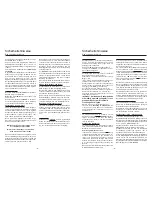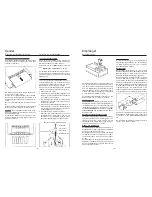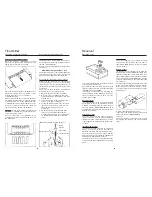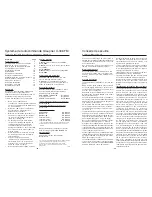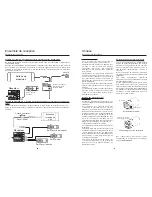
Charging the transmitter battery
If the transmitter is fitted with NC cells, they can
be recharged via the charge socket mounted on
the side of the transmitter.
Be sure to use genuine Graupner charge leads
exclusively.
Maximum charge current 1 A !!!
The transmitter battery cannot be charged using
an automatic charger due to the reverse-flow
protection circuit installed in the transmitter.
Converting the transmitter sticks (optional)
Either of the two sticks can be converted from
self-neutralising action to non-neutralising
(ratchet) action, e.g. for controlling the motor or
throttle, where the stick is required to stay in the
set position.
The accessory pack, Order No. 3145.80 (not
included in the set) is required for this.
1. Open the back panel of the transmitter.
2. Disconnect the coil spring attached to the
stick unit. Raise the neutralising return lever
and remove it.
3. Unscrew the stick rocker retaining screw
using a cross-point screwdriver.
4. Locate the threaded pillar in the accessory
pack and screw it into the stick rocker as
far as it will go, using a slot-head
screwdriver.
5. Fix the leaf spring on the threaded pillar
using the screw and washer supplied,
ensuring that the tongue of the spring rests
on the knurled disc adjacent to the stick
rocker.
- 18 -
Fitting the transmitter batteries
Open the battery compartment cover by
pressing it in gently at the marked point and
sliding it in the direction of the arrow.
Transmitter
Fitting the transmitter batteries
Converting the transmitter sticks
Order No. 3145.80 Ratched spring set
Place the cells in the battery compartment (see
illustration), taking care to maintain correct
polarity. Close the cover of the battery
compartment again.
Switch on the transmitter to check the batteries:
the battery monitor LEDs should now indicate
a full battery.Switch off the transmitter after
completing the check.If the transmitter is not to
be used for a while the batteries should be
removed from the battery compartment.
Caution:
The life of the batteries is limited, and
the battery compartment should therefore be
checked from time to time.
Remove exhausted cells immediately, as
escaping electrolyte can damage and even ruin
the transmitter.
Screw
Washer
Leaf spring
Threaded pillar
Spring tongue
Power supply
The power supply for the complete receiving
system can either be drawn from the drive or
flight battery (BEC system), or from a separate
receiver battery.
Battery holder
If a separate receiver battery is to be used, the
battery holder should be fitted with four AA cells.
Install the cells with correct polarity, and wrap a
rubber band round the battery holder for additio-
nal security. Apply thick insulating tape over the
exposed contacts to which the connecting leads
are soldered.
Pack the battery holder in foam rubber to protect
it from shock and vibration and stow it in the
model. The leads must have plenty of „slack“,
i.e. they should not come under strain even if the
battery moves.
- 19 -
Receiver
Operating notes
This receiver features an RF input filter for good
selectivity, while high-quality,
mechanically robust LC filters provide superb
adjacent channel rejection. An integrated circuit
exploiting low-current CMOS
technology is responsible for decoding the
received signals for the individual servos.The
receiver features sockets for up to 4 servos
and the power supply.
Receiver crystal
The channel number of the receiver crystal must
be the same as that of the transmitter crystal. It
is fitted in an opening in the top of the case. You
must use genuine GRAUPNER FMsss plug-in
crystals with a grey protective cap and the code
letter R (for receiver).
Polarised sockets
The servo connectors and power supply can
only be connected to the receiver the right way
round. You will find a slight chamfer on one side
of the plugs which mates with the profile of the
sockets.
Installing the receiver
The receiver must be packed in soft foam and
stowed in the model in such a way that it is
protected effectively from dirt, dust and spray.
The receiver must not make contact with the
model itself at any point, otherwise vibration and
shocks will be transmitted directly to it.
Secure the receiver in such a way that the aerial,
servo leads and power supply lead are not under
strain.
A 4.8 V rechargeable battery can be
connected to the system instead of the battery
holder: see the main GRAUPNER FS
catalogue.
The power supply is connected to the receiver
by inserting the plug into the socket marked
„Batt.“.



